Understanding the Current Trends in Interest Rates and Inflation

Analyzing Market Trends in Interest Rates and Inflation
This week started slowly due to market closures, yet anticipation builds as the midweek approaches. The Federal Open Market Committee (FOMC) minutes are set to be released, shedding light on the central bank's recent decisions. Additionally, we will receive important initial and continuing jobless claims data on Thursday.
Friday will bring the much-anticipated Flash PMI data from S&P Global alongside the final Michigan consumer sentiment readings for the month. The data is crucial for assessing inflation expectations, particularly after some surprising preliminary results showed a noticeable increase. The trend in regional Federal Reserve data is essential as it offers insights into labor market dynamics and inflationary pressures, affecting how investors perceive the economy's trajectory.
On Thursday and Friday, the 10-year rates declined, coinciding with the latest Producer Price Index (PPI) report. While the Consumer Price Index (CPI) indicated strong inflation, PPI's cooler results provided a moment of relief. Despite heightened core Personal Consumption Expenditures (PCE) expectations post-CPI, the market adjusted following the PPI report, keeping inflation expectations stable around 3% for the foreseeable future.
A noteworthy aspect is the trend in inflation swaps. The recent breakout of one- and two-year inflation swaps suggests a shift in inflation outlooks among market participants. If this trend continues, it could indicate further movement upwards in rate expectations, influencing decision-making for both consumers and investors.
While some might argue that the PPI report improved the inflation landscape, evidence suggests the market remains cautious. Inflation expectations are currently elevated, and any swift pivots in these assumptions remain uncertain. Historically, the trajectory of the 10-year Treasury yields has shown correlation with inflation swaps. Should inflation swap values continue to trend upwards, it raises the likelihood that yields will also rise, undermining recent declines in rates.
In exploring the external factors impacting rates, commodities are a pivotal element. Recent surges in copper prices have brought significant attention. As of late last week, copper prices hovered near $4.70, stirring discussions on the potential for further inflationary impacts if trends persist. Should copper approach $5, this could foster stronger inflation expectations.
The oil market presents an interesting dynamic as well. Recent fluctuations have left oil hovering around pivotal retracement levels. Price movement above or below key thresholds may prefigure either a bullish trend or signify weaker price action, influencing overall inflation strategies. Similarly, gasoline prices are experiencing gradual increases, contributing to potential rate hikes if the upward trajectory continues.
The equity markets have myriad influences at present. The approaching options expiration week signifies significant positioning and potential resistance levels around the S&P 500. With the index encountering substantial gamma levels around 6,100, the outcome of this week's trades remains uncertain.
From a technical analysis standpoint, the S&P 500 currently rests at the upper boundaries of Bollinger Bands, and the Relative Strength Index (RSI) is showing signs of pulling back. If the S&P breaks above 6,150 with substantial trading momentum, the potential for market shifts could be significant.
However, the relatively stable implied volatility suggests indecision in the markets. With the VIX hovering around 14-14.5, any major price movements will heavily depend on how volatility trends intersect with traders’ expectations. The implied correlation index has dipped to record lows, indicating a possible decrease in broader market movements unless volatility subsides.
Given the interplay of these factors, elongated interest rates may continue their upward trend, driven by inflation expectations influenced by commodity markets, particularly copper, oil, and gasoline prices.
Frequently Asked Questions
What are inflation swaps and their importance?
Inflation swaps are derivative contracts where parties exchange cash flow based on inflation rates. They are crucial for hedging against inflation risks.
How does the core PCE index relate to inflation expectations?
The core PCE index measures inflation excluding volatile food and energy sectors, serving as the Federal Reserve's primary gauge for policy decisions.
What does the PPI report indicate about future inflation?
The PPI report reflects the average change in selling prices received by producers, acting as a precursor to consumer inflation metrics like CPI.
How do gamma levels affect the equity markets?
Gamma exposure illustrates how price changes impact market makers' hedging, influencing support or resistance levels within equity markets.
What potential impacts do commodities like copper and oil have on interest rates?
Rising commodity prices can enhance inflation expectations, prompting higher interest rates as markets react to anticipated inflationary pressures.
About The Author
Contact Ryan Hughes privately here. Or send an email with ATTN: Ryan Hughes as the subject to contact@investorshangout.com.
About Investors Hangout
Investors Hangout is a leading online stock forum for financial discussion and learning, offering a wide range of free tools and resources. It draws in traders of all levels, who exchange market knowledge, investigate trading tactics, and keep an eye on industry developments in real time. Featuring financial articles, stock message boards, quotes, charts, company profiles, and live news updates. Through cooperative learning and a wealth of informational resources, it helps users from novices creating their first portfolios to experts honing their techniques. Join Investors Hangout today: https://investorshangout.com/
The content of this article is based on factual, publicly available information and does not represent legal, financial, or investment advice. Investors Hangout does not offer financial advice, and the author is not a licensed financial advisor. Consult a qualified advisor before making any financial or investment decisions based on this article. This article should not be considered advice to purchase, sell, or hold any securities or other investments. If any of the material provided here is inaccurate, please contact us for corrections.
